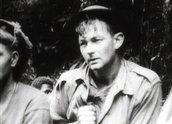
Kokoda Front Line! (1942)
Synopsis
This Academy award-winning Cinesound Review newsreel special shows Australian troops on the Kokoda track in the jungles of New Guinea during the Second World War. It features footage shot by war correspondent Damien Parer for the Commonwealth Department of Information. It contains an opening address to camera by Parer and voice-over commentary by actor Peter Bathurst.
Curator’s notes
This iconic newsreel contains some of the most recognised images of Australian troops in the Second World War, images that have contributed to the collective visual memory of the events at Kokoda. This newsreel presented audiences with visuals of the war unlike any they had seen. The shots of the troops trudging through the thick tropical jungle and being hauled on stretchers over narrow muddy passages stood in stark contrast to the open battlefields of Europe. It was the first time that audiences saw the gruelling conditions under which the campaign in the Pacific was being fought, a war that seemed until this point 'a million miles away’ (as Parer notes in his opening address to camera). Parer’s experience filming in New Guinea convinced him that people back in Australia needed to realise that the war was closer than they thought. He wanted to shake people out of their complacency and alert them to the urgency and importance of the campaign. Parer had gained his credentials in the Middle East where he covered the war with fellow adventurer and cinematographer Frank Hurley. His trustworthiness as an 'experienced and reliable observer’ is described in the introductory text of the newsreel.
Parer was sent to New Guinea by the Department of Information in August 1942, by which time Australian troops were positioned in the jungles behind Port Moresby to counter the Japanese forces. At Kokoda, the inexperienced 39th Battalion had already begun a fighting withdrawal along the track. That Parer is filming their retreat is masked by the courageous spirit of the men, captured by Parer in all their bravery and suffering. Unusually for a war newsreel, there is no actual fighting in Kokoda Front Line!. That the Japanese were 'masters of camouflage and deception’ is represented through their very absence from the film. Instead, Cinesound’s chief director, Ken G Hall, created intense drama from Parer’s footage through showing the physical and emotional battle of the troops in rugged and unwelcoming terrain.
Parer placed himself ahead of the troops, often filming from precarious locations in order to present the steep inclines and narrowness of the track. Lugging his 35mm camera and film stock (which only lasted for one minute at a time), Parer’s determination to present an emotionally true account of events as he saw them resulted in some of the most memorable images of the Second World War. Standout sequences include the Papuan stretcher bearers carrying the wounded over fast-flowing rivers and up steep inclines; bandaged and wounded soldiers recuperating at a village hut; the parade of the 39th Battalion at Menari after their retreat from Kokoda; and probably the most famous of all – members of the Battalion, framed from the waist down, trudging through ankle-thick mud along the track. Parer’s still and moving pictures have themselves become documents for historical research – used, for example, as evidence that the Papuan carriers largely hailed from coastal tribes and not from those in the Kokoda area. The recent Australian feature film, Kokoda (2006), recreates Parer’s work and uses camera angles and frame compositions based on his filming in New Guinea.
The weekly Cinesound Review – billed as the 'voice of Australia’ – began in the early 1930s with the coming of sound film. Cinesound Productions had successfully produced feature films during the 1930s but ceased not long after the war started. The Cinesound Review came into its stride during the years of the Second World War when events provided Cinesound with its best and most memorable material. Fox Movietone News, a contemporary of the Cinesound Review, also produced a newsreel special on Kokoda (see Road to Kokoda, 1942) using Parer’s footage and many of the same key sequences, but it did not create nearly the level of interest or impact that Hall’s production had. This could be due to the extra believability created in Cinesound’s edition from Parer’s introductory speech to camera (which, in a stroke of genius by editor Terry Banks, is reprised in the closing moments of the film). It is Parer’s measured sincerity and first person account of events in New Guinea which give the film its weight. Parer’s pictures say a lot on their own, but newly returned from the front-lines, with Kokoda still on his mind, Parer convincingly and urgently argues that the war is ‘just outside our door’.
This newsreel was first screened on 18 September 1942.
- Overview
- Curator’s notes
- Video 1 clip

- Principal credits
- Find a copy
- Make a comment
- Map
- Add your review



